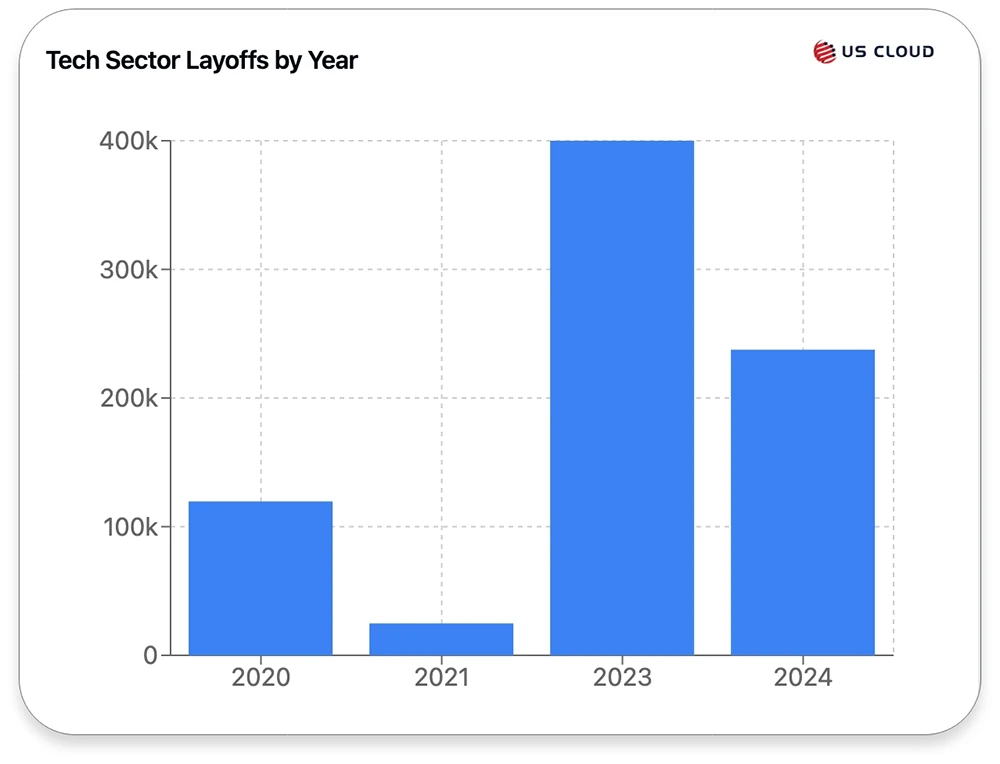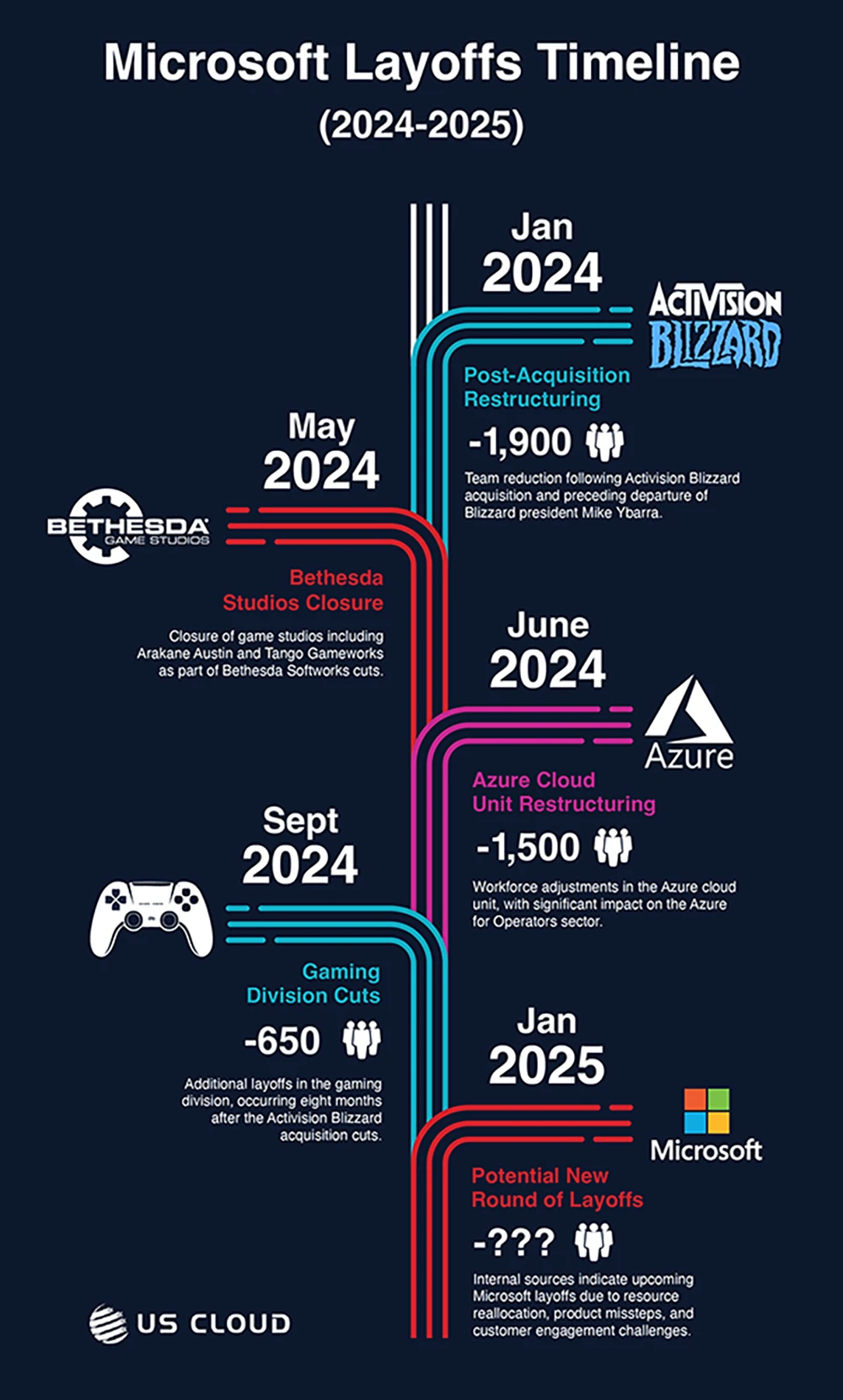
Sources Point to Significant Microsoft Layoffs Coming in 2025.

In 2024, significant headwinds impacted support delivery and pushed more enterprise offerings into Microsoft’s V-Dash network. This year, internal sources are pointing to reallocated resources and a struggling AI initiative as driving forces behind an upcoming 5% layoff…with Unified support on the chopping block again.
Read through until the end for more about how US Cloud helps businesses maintain a lifeline of reliable Microsoft support in the face of strategic layoffs at Microsoft.
Overview of Tech Layoffs in 2024
It’s no secret that a wave of tech layoffs affected several major companies this past year. As of the time of writing this post, layoffs in the tech sector alone account for the loss of over 237,476 jobs. While this is not as high as the count for 2023 (that’s over 400k!), it is significantly higher than the impact count for 2020 (at 119.6k) and 2021 (only about 24.8k).

These company-wide changes typically precede a period of adjustment within the company unless the business creates some airtight transition plans. Sometimes, layoffs at tech companies may be accompanied by slower product updates, reduced tech support, or possible service interruptions
Unemployment rates for the United States are currently hovering at around 4.2%, but historically the unemployment rate in the tech industry has been much lower at around 2.5% at the time of writing this piece. However, this rate has been somewhat volatile this year: unemployment in the tech sector rose to a four-year high this past June at 3.7%.
One culprit of the rise in unemployment in this sector is layoffs at influential companies—including Microsoft. During this time, third-party support providers have been supplying businesses with a consistent connection to Microsoft solutions, allowing businesses to experience uninterrupted service.
Why Do Technology Companies Lay Off Employees?
While reasons for why layoffs happen naturally vary, one common reason for large swaths of layoffs typically has to do with resource allocation. If a business realizes they must move funds or jobs to different initiatives, for example, restructuring could occur.
Sources such as R&D World announced findings that AI drove significant restructuring across technology sectors, specifically noting that Microsoft’s Azure team cuts in 2024 were enacted while sustaining an AI development focus.
Microsoft Layoffs in 2024 and Beyond
Microsoft laid off employees at various times throughout the year, with the largest layoff affecting the gaming and cloud computing sectors of the company. With the Activision and Azure teams losing so many members, Microsoft joined the ranks of big tech names adjusting their workforce to align with economic fluctuations and company-wide initiatives.
Here’s a timeline of when Microsoft layoffs occurred and in which sector:
- January 2024: Microsoft downsized their team by about 1,900 employees directly following the Activision Blizzard acquisition and preceding the departure of former Blizzard president, Mike Ybarra.
- May 2024: As part of cuts at Bethesda Softworks, Microsoft shut down game studios such as Arkane Austin, Tango Gameworks, and more.
- June 2024: Microsoft laid off hundreds of employees in their Azure cloud unit, citing general organizational needs for workforce adjustments. One anonymous source estimated that as many as 1,500 job cuts were involved int he Azure for Operators
- September 2024: Microsoft laid off approximately 650 more employees in the gaming division (just eight months after cutting 1,900 jobs following the acquisition of Activision Blizzard).
- January 2025: Internal sources point to a new round of layoffs, possibly as a result of reallocated resources, product missteps, customer engagement challenges, and more.
If we don’t count exact numbers from May 2024 (which include whole studios shutting down and, therefore, several jobs lost), Microsoft laid off approximately 4,050 internal employees in 2024 alone. As we mentioned before, internal sources indicate that the 2025 calendar year will kick off with a fresh round of Microsoft layoffs.

Tech Layoffs Pose Risk of Limited Customer Support
Layoffs or job cuts may pose customer support risks in the sectors from which they have been cut. Such risks include delayed troubleshooting, slower responses for critical issues, lower frequency of patch updates.
This is risky for businesses of all sizes, but especially for larger enterprises that rely heavily on Microsoft products like Office 365, Azure, Outlook, Dynamics 365, and more. Any business that operates on a Microsoft system must have a support team to back them up. If that team is unavailable to resolve issues in a timely manner, the delay could come at a high cost.
Third-Party Services Bridge the Gap for Service Reliability

For business leaders who like to have contingency plans in place for emergencies, US Cloud is ready to help you make a plan against Microsoft issues. Our team provides the specialized expertise businesses require with the continuity that they need.
At US Cloud, we ensure high-quality Microsoft solutions despite shifts in internal resources at Microsoft. Our cost-effective support options include:
- 30-50% savings on Microsoft support compared to Unified or Premier tiers of Microsoft Support
- Flexible contracts through which your team can only pay for what you need, not just a one-size-fits-all package.
- Reactive Microsoft support to guide your team through the solutions that will help get your systems back up and running.
- Proactive Microsoft support to monitor and prepare your system against future threats.
- Pay-as-You-Go Models without hidden fees help you budget accurately for Microsoft support services.
Choose from the following tiers of support to meet the needs of your team:
- Basic Enterprise Support
- Enhanced Enterprise Support
- Premium Enterprise Support
For more about which tier best fits your company, request more information from US Cloud.
US Cloud Reduces the Risk of Microsoft Support Interruptions
Interrupted services from direct Microsoft support can cause a significant ripple effect throughout the business. For example, in the case of health institutions, Microsoft downtime can severely impact patient care.
Ed Panzeter, Assistant IT Director at Universal Health Services, Inc. (UHS), noted the following about service through US Cloud:
“I think our experience with US Cloud has actually been better than Microsoft, because when we are down, we require response as quickly as possible. With US Cloud we get calls back within 15 minutes.
I think our experience [with US Cloud] is much more positive than any experience we’ve ever had with Microsoft, and I think that’s one of the reasons that we were successful in this change. It’s a big pill to swallow for an organization, especially a large organization, to step away from first party support. A big part of us being successful in moving to US Cloud was that responsiveness.”
Read more about what he and Director of IT at UHS, Kristin Mondi, say about US Cloud in this case study.
Although the UHS team initially switched to US Cloud to take advantage of a serious cut in service costs, they eventually grew to rely on the rapid issue resolution they experienced by working with our team of experts.
Outlook for Microsoft Support: What to Expect in the Future
Based on what we know about the Microsoft support landscape, here’s what we can expect from the year to come (and beyond):
- Layoffs to Continue Impacting the Tech Industry
Tech layoffs will not end and will continue to shape the industry for years to come. Accordingly, Microsoft will continue to adjust its workforce as needed in order to meet its resource and initiative needs. - Rise in Third-Party Support
Third-party support needs will rise as customers seek reliable, uninterrupted services and a responsive support model. As future layoffs continue to shake Microsoft and other tech giants, businesses will need consistent solutions to stay on track. - Technology Advancements to Increase Support Needs
Tech innovations will continue to support the growth of businesses worldwide, making third-party services increasingly viable alternatives to traditional direct support. Business leaders who position themselves at the forefront of progress by pushing the boundaries of current technology will not want to be held back by Microsoft issues.
Future-Proof Your Productivity with Microsoft Third Party Support
Our team is prepared to support you through your most productive year yet. We make sure that your team’s progress is unhindered by Microsoft issues of any kind. Contact US Cloud today to start future-proofing your team’s productivity.
Microsoft Layoff FAQs
Will Microsoft layoffs happen in 2025?
Internal sources indicate that the 2025 calendar year will begin with Microsoft layoffs affecting one or more divisions of the company.
Why would Microsoft layoffs happen?
Sources say that Microsoft might be in the position to restructure the company to some extent due to shifting focus on AI, failed product initiatives, and struggling customer support conditions.
Why did Microsoft lay off employees in 2024?
Microsoft layoffs mainly happened in 2024 as the company acquired Activision Blizzard and as Azure priorities shifted.
Does Microsoft do layoffs often?
Yes, this company is known to enforce layoffs fairly frequently. It appears that layoffs in some form occur annually at Microsoft, with heavier layoffs possibly happening at the beginning of the year.



